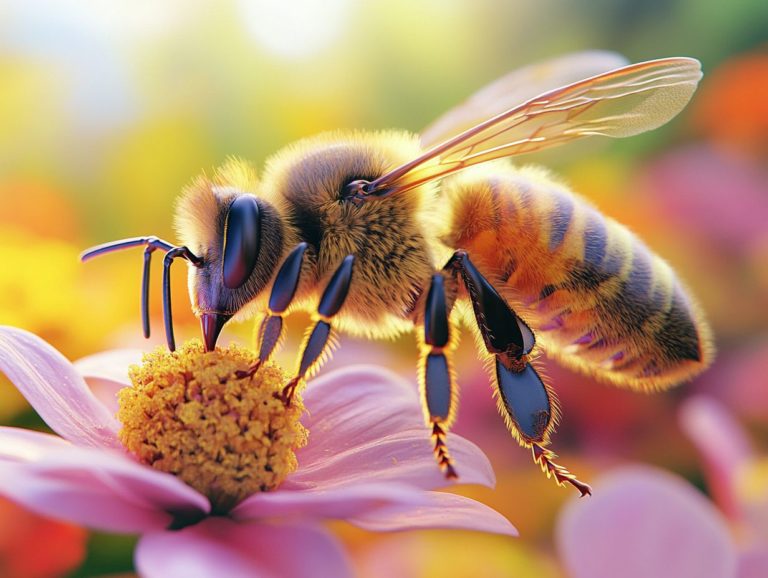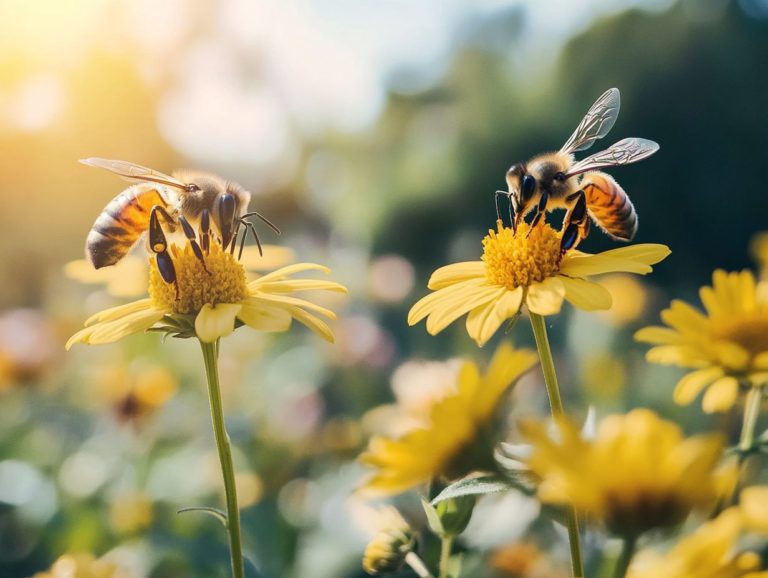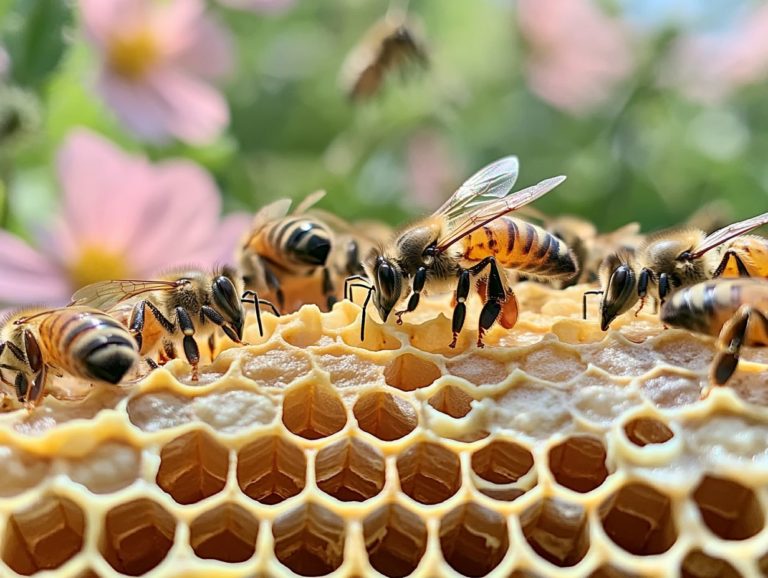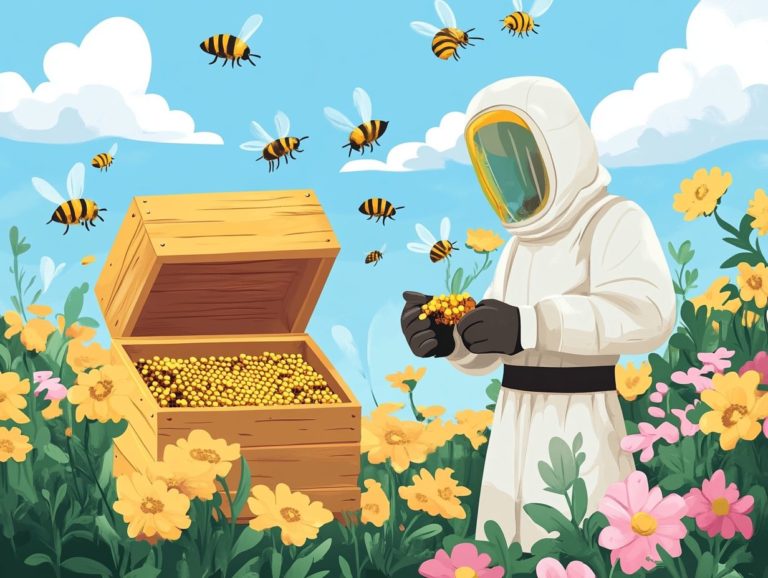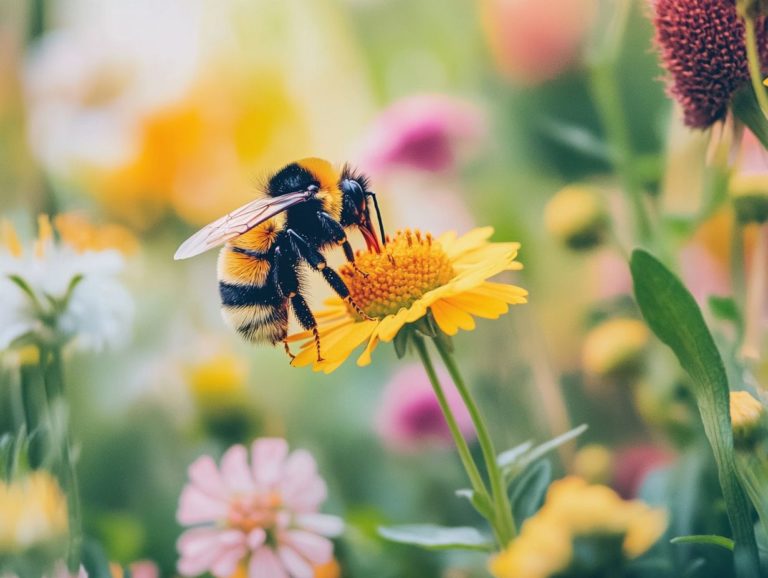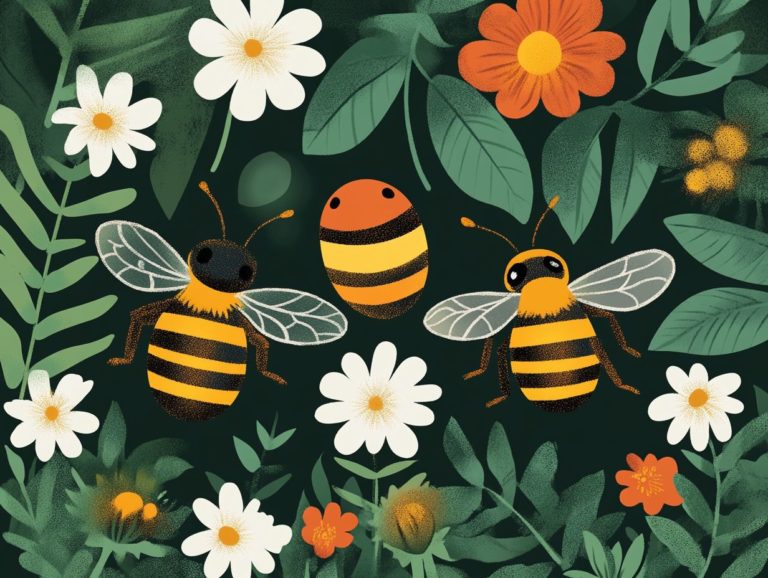The Effects of Pollution on Bee Behavior
Pollution extends beyond being merely an environmental issue; it represents a significant threat to our essential pollinators bees, including species like Bombus terrestris. As you delve into the various types of pollution, you ll uncover the ways it disrupts bee behavior and health. This disruption ultimately impacts their vital role in pollination.
The discussion also encompasses the broader factors contributing to the decline of bee populations, such as pesticides, habitat loss, and climate change. There are practical steps you can take to support these crucial creatures.
Engage with us as we examine the impact of pollution on bees and discover how you can make a meaningful difference in promoting a healthy environment.
Contents
- Key Takeaways:
- What is Pollution?
- The Impact of Pollution on Bees
- Factors That Contribute to Bee Decline
- What Can We Do to Help Bees?
- Frequently Asked Questions
- What is pollution and how does it affect bee behavior?
- What are some examples of pollution that can affect bees?
- How does pollution impact bee reproduction?
- Can pollution affect the social behavior of bees?
- Are there any long-term effects of pollution on bee behavior?
- How can we reduce the negative effects of pollution on bee behavior?
Key Takeaways:
Here are some key takeaways to remember:
- Pollution can negatively impact bee behavior, health, and their ability to pollinate effectively.
- Pesticides, habitat loss, agriculture, and climate change are among the top contributors to bee decline.
- To help bees, we need to reduce chemical use, plant bee-friendly gardens, and support local beekeepers, thereby enhancing public awareness.
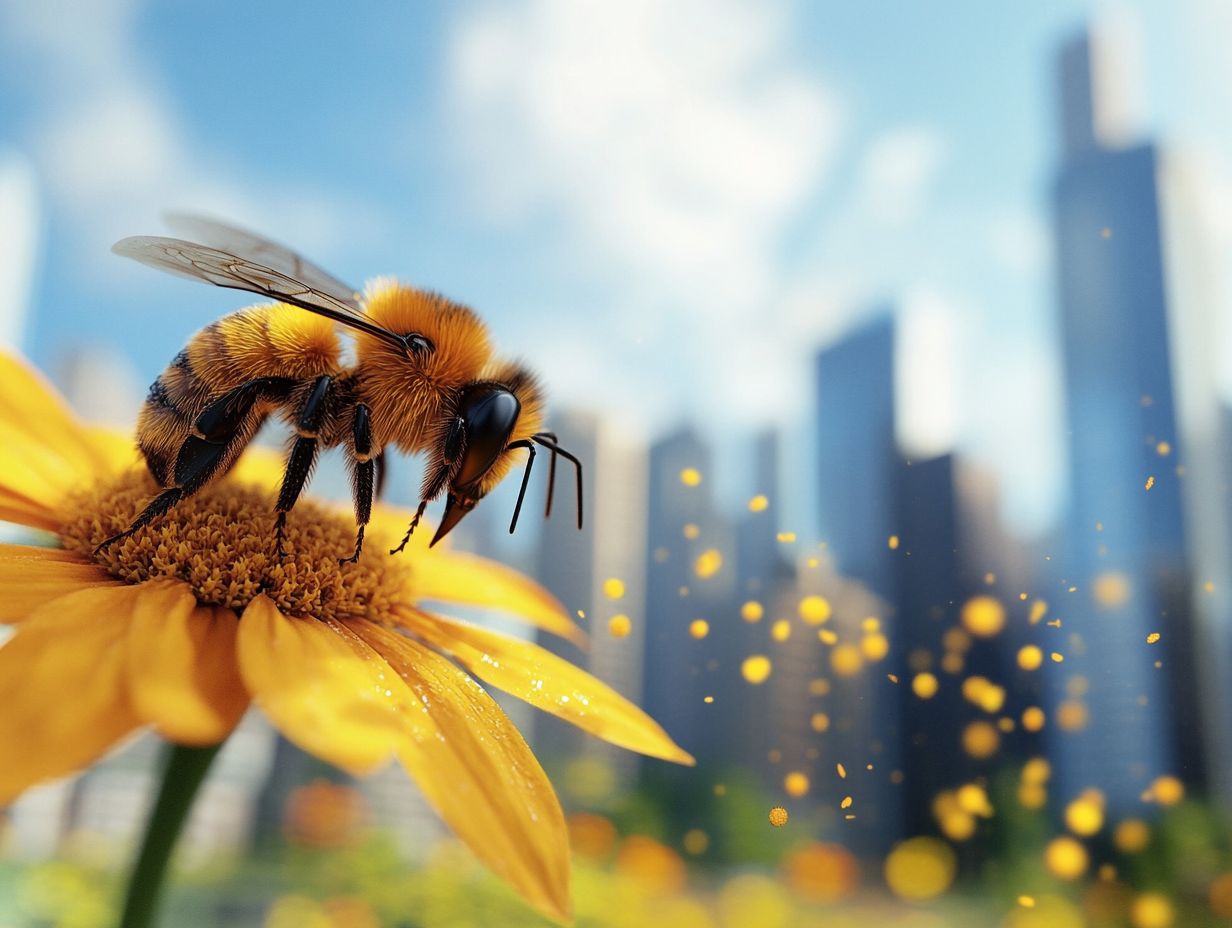
What is Pollution?
Pollution is the introduction of harmful substances or contaminants into the natural environment, and it can significantly damage ecosystems, human health, and biodiversity.
Entities like Natural England work to mitigate these impacts and promote sustainable practices. You should be aware that various forms of pollution, especially air pollution, play a crucial role in climate change.
Air pollution can deteriorate air quality, resulting in adverse environmental impacts on wildlife and ecosystems. Key pollutants, such as nitrogen deposition, can lead to eutrophication, which is the excessive growth of algae due to nutrient overload, disrupting delicate ecosystems that support pollinators.
Understanding the different types of pollution and their implications for the environment is essential for fostering a healthier planet.
What Are the Different Types of Pollution?
You encounter several types of pollution, each leaving its mark on the environment in distinctive ways. The most prevalent forms include air pollution, water pollution, land pollution, and noise pollution.
Air pollution, typically stemming from industrial emissions and vehicle exhaust, can significantly degrade air quality and contribute to climate change. Meanwhile, water pollution, fueled by agricultural runoff and harmful chemicals, poses a serious threat to aquatic ecosystems and biodiversity, including bee diversity.
Land pollution primarily arises from improper waste disposal and the excessive use of pesticides, leading to soil degradation and jeopardizing food security. Noise pollution, often brushed aside, originates from urban environments and transportation systems, adversely affecting human health and the behavior of wildlife.
By understanding these different types of pollution, you can devise targeted strategies to mitigate their impacts. For instance, embracing renewable energy sources can dramatically cut down on air pollution.
The Impact of Pollution on Bees
Pollution has a significant effect on bees, the critical pollinators that support many flowering plants and play a crucial role in sustaining ecosystems and ensuring food security. Honey bees, in particular, encounter various threats stemming from environmental pollution.
This results in declines in bee diversity, honey production, and overall bee health. Given that bees are vital contributors to agricultural production and the overall vitality of our environment, this decline is alarming.
Have you ever wondered how pollution affects our essential pollinators like bees? Join us in making a difference today every small action counts!
How Does Pollution Affect Bee Behavior?
Pollution has a profound impact on bee behavior. Research shows that exposure to pesticides and other pollutants can significantly alter how honey bees forage, navigate, and communicate.
Environmental changes driven by air pollution can result in a shortage of nectar-rich flowering plants. These plants are crucial for bees to gather food and thrive.
Harmful substances disrupt the delicate balance of their searching for food, making it increasingly challenging for these essential pollinators to find food sources, including nectar sugar from flowering plants.
Honey bees rely heavily on chemical signals that bees use to communicate, but in contaminated environments, they may struggle to decipher these vital signals.
As these chemical disturbances persist, their natural instincts for efficient navigation begin to falter. This disorientation ultimately impacts the entire hive’s productivity.
This ripple effect does not only pose a threat to individual bees; it jeopardizes the critical role they play in pollinating crops and supporting biodiversity. This situation is critical! We must address the factors endangering these remarkable creatures and the ecosystems they sustain.
What Are the Effects of Pollution on Bee Health?
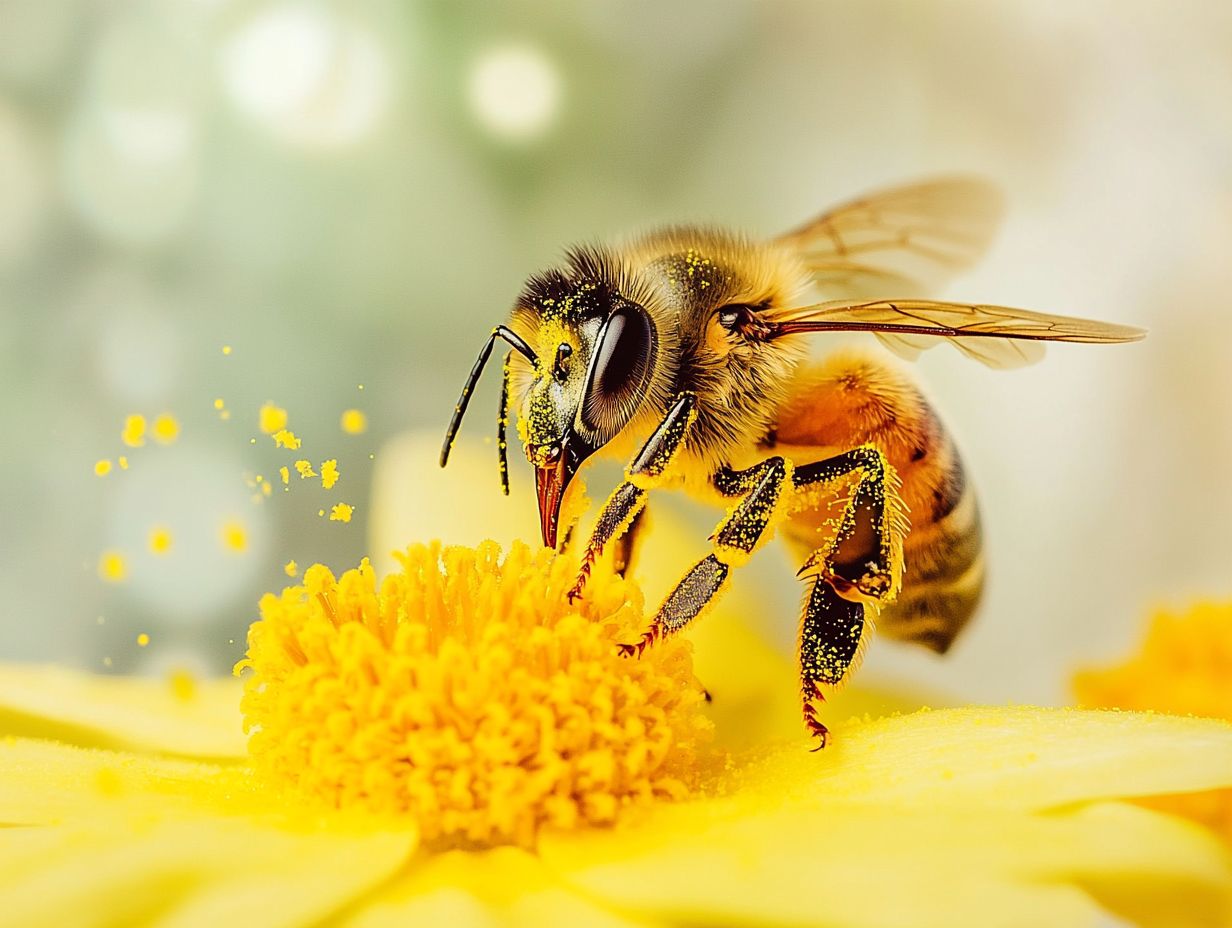
Have you ever wondered how pollution impacts your local bees? The health of bees, especially honey bees, is significantly compromised by various forms of pollution.
These pollutants make them more vulnerable to diseases and parasites like Varroa destructor and N. ceranae. Pollution undermines their immune systems, increasing their susceptibility to stressors and diminishing their overall lifespan.
Environmental pollutants such as pesticides, heavy metals, and microplastics disrupt the fragile balance within bee populations. These harmful substances can decrease foraging efficiency, impair reproductive capabilities, and disturb the gut microbiome an essential component for digestion and immunity.
As honey bees navigate through increasingly polluted habitats, their exposure to these toxins amplifies the challenges presented by harmful microorganisms. The decline in floral resources due to habitat degradation makes the situation worse, leading to malnutrition and further weakening bee colonies.
Recognizing these intricate relationships is vital for crafting effective strategies to protect these essential pollinators.
How Does Pollution Affect the Bee’s Ability to Pollinate?
Pollution significantly hampers their ability to pollinate effectively, especially when it comes to honey bees those remarkable creatures essential for the reproduction of countless flowering plants.
When bees are exposed to air pollution, the scent cues that draw them to flowers become diminished. This ultimately impacts their foraging efficiency and the critical pollination services they provide.
Chemical pollutants, including pesticides and heavy metals, can jeopardize the health of bee populations. They weaken immune systems and diminish reproductive success, leading to a decline that affects not just individual bee behavior but the entire ecosystem.
As flowering plants rely heavily on these pollination services, a decrease in bee populations can result in lower crop yields and reduced availability of your favorite fruits and vegetables.
This intricate relationship underscores the urgent need to tackle pollution and its extensive consequences on both pollinators and plant life.
Factors That Contribute to Bee Decline
The decline of bee populations is a complex issue rooted in multiple factors that demand your attention.
From the pervasive use of pesticides to the loss of habitats driven by urbanization and agriculture, and the ongoing effects of climate change and pests, each element plays a critical role.
These challenges not only jeopardize the survival of bees but also carry significant implications for food security and agricultural production, considering the vital role bees play in pollination.
Pesticides and Chemicals
Pesticides and chemicals present a serious threat to bee populations, particularly impacting honey bees and their ability to flourish in polluted environments. These substances can disrupt your bees’ foraging behavior, reproduction, and overall health, leading to declining populations and diminished biodiversity.
Research has shown that exposure to neonicotinoids, a class of systemic insecticides, can significantly impair cognitive function in bees, hindering their ability to navigate and locate food sources effectively. The loss of ecosystem services due to reduced bee populations has a cascading effect on biodiversity and food production.
A notable study revealed that honey bees exposed to these chemicals displayed decreased foraging efficiency, resulting in less pollen and nectar being collected, which ultimately threatens the viability of their colonies.
Chronic exposure to pesticides can also disrupt hormonal balance in bees, negatively affecting their reproductive success and longevity. When you consider these factors together, it becomes glaringly evident how environmental pollution from agricultural practices not only jeopardizes honey bees but also endangers the entire ecosystem they help sustain.
Habitat Loss
Habitat loss is a significant factor in the decline of bee populations, as the transformation of land for agriculture and urban development diminishes the availability of flowering plants that provide the essential resources bees need. This loss of biodiversity doesn t just impact bees; it sends ripples through entire ecosystems, disrupting the services they offer.
The consequences of shrinking natural habitats extend far beyond merely reducing bee numbers; they severely hinder pollination capabilities, which are vital for the reproduction of numerous flowering plants. Bees, including species like Bombus terrestris, are instrumental in maintaining ecosystem health by promoting the growth of a diverse array of plants that support other wildlife. When flowering plants like Succisa pratensis dwindle, the food web becomes unbalanced, resulting in further declines in species that rely on these plants for survival.
Thus, protecting and restoring natural habitats is crucial not only for the bees themselves but for the broader biodiversity that sustains life on our planet.
Climate Change
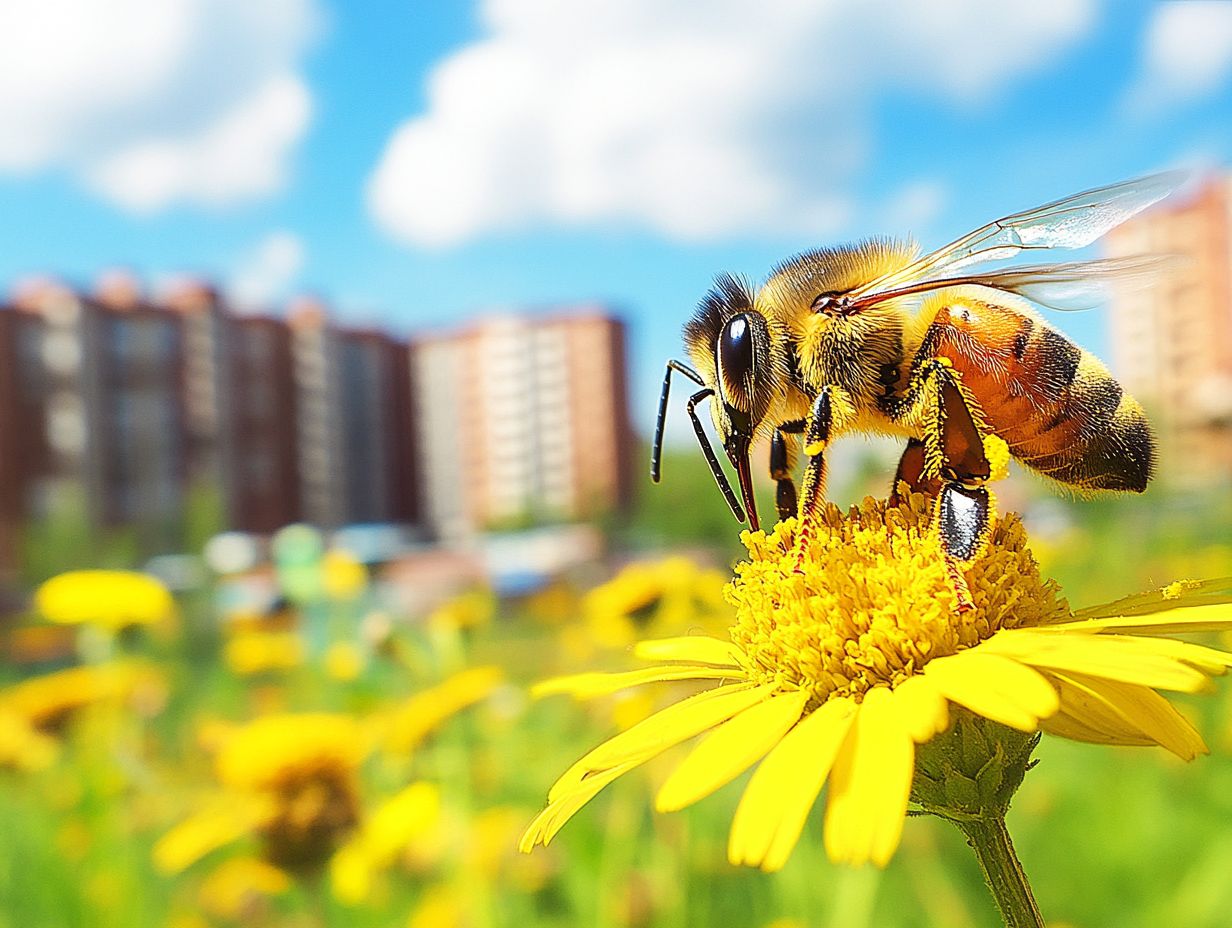
Climate change has a profound effect on bee populations, reshaping their habitats, disrupting flowering times, and impacting the availability of food sources. As temperatures continue to rise and weather patterns become increasingly erratic, the delicate timing between bees, including honey bees, and blooming plants is thrown off balance. This misalignment can lead to reduced pollination, posing a significant threat to food security.
These environmental shifts can also alter bees’ foraging behavior, forcing them to search for flowers that may no longer be blooming or available at the right times. With the decline in plant diversity driven by various environmental stresses, bees find it increasingly difficult to access the nutrients essential for their survival. This nutritional strain results in weakened immune systems, leaving them more vulnerable to diseases and parasites like Varroa destructor and N. ceranae.
In the grand scheme of things, the cascading effects of climate change not only place bee populations at risk but also endanger the ecosystems that depend on these vital pollinators for reproductive success and biodiversity.
What Can We Do to Help Bees?
To combat the decline of bee populations and support their essential role in ecosystems, you can take a variety of impactful actions.
- Consider reducing your chemical use,
- planting bee-friendly gardens, and
- supporting local beekeepers.
These efforts contribute to a healthier environment for bees, enhance their diversity, and play a crucial role in ensuring food security for future generations.
By making these conscious choices, you can help create a thriving habitat for these vital pollinators.
Reducing Chemical Use
Reducing chemical use, particularly pesticides, is essential for supporting bee populations and fostering a healthy environment. By choosing organic farming practices and minimizing harmful chemicals, you have the power to create safer habitats for bees. This significantly enhances their chances of survival.
This shift not only benefits these vital pollinators but also contributes to the overall health of ecosystems. You can play a crucial role by cultivating native plants that provide food sources for bees while steering clear of synthetic fertilizers and pesticides in your own garden.
Farmers, too, can adopt methods that use natural pest control and pest-resistant crops, dramatically decreasing their reliance on chemical interventions. These thoughtful choices lead to healthier soil and water systems, while also promoting biodiversity and creating vibrant ecosystems where bees and other beneficial insects can truly flourish.
You can also reduce nitrogen deposition and combat eutrophication, which is the excess nutrients in water that can lead to harmful algal blooms. This further supports ecosystem services that benefit bees.
Planting Bee-Friendly Gardens
Planting bee-friendly gardens is an exceptional way for you to provide critical resources for bees. These gardens offer pollen and nectar from a diverse array of flowering plants. By cultivating these gardens, you enhance biodiversity, support local ecosystems, and attract a variety of pollinators, including honey bees and other beneficial insects. This helps mitigate the environmental impacts that threaten bees.
Incorporating a diverse selection of native flowering plants, such as lavender, sunflowers, and coneflowers, allows you to create vibrant habitats that cater to the unique needs of different bee species. These plants not only serve as essential food sources but also encourage other beneficial wildlife, fostering a balanced ecosystem. Species like Euphydryas aurinia benefit greatly from such environments.
By choosing flowering species that bloom at various times throughout the year, you ensure that pollen and nectar are available during the entire growing season. This is crucial for maintaining healthy bee populations.
Your commitment to plant diversity ultimately supports sustainable gardening practices that benefit both pollinators and the overall environment. These efforts also help maintain agricultural production by ensuring consistent pollination.
Supporting Local Beekeepers
Supporting local beekeepers is essential for ensuring the health of bee populations and the sustainability of honey production. By purchasing honey and bee-related products from local sources, you actively contribute to the maintenance of robust bee colonies while promoting food security within your community.
Local beekeepers play a critical role in enhancing biodiversity and boosting agricultural productivity through their invaluable pollination services. Encouraging a flourishing beekeeping culture in your area can lead to an increase in both the quantity and quality of local crops, which is vital for resilient food systems.
This support not only creates job opportunities but also invigorates local economies, as beekeeping often sparks related agri-business ventures. Organizations like Natural England can provide support and resources for promoting sustainable beekeeping practices.
When you and your community rally behind your beekeepers, you not only savor fresher, more authentic honey but also help build resilience against the environmental stresses that threaten bee populations. This collective effort secures a healthier ecosystem for generations to come, ensuring the continued provision of ecosystem services that benefit all.
Frequently Asked Questions
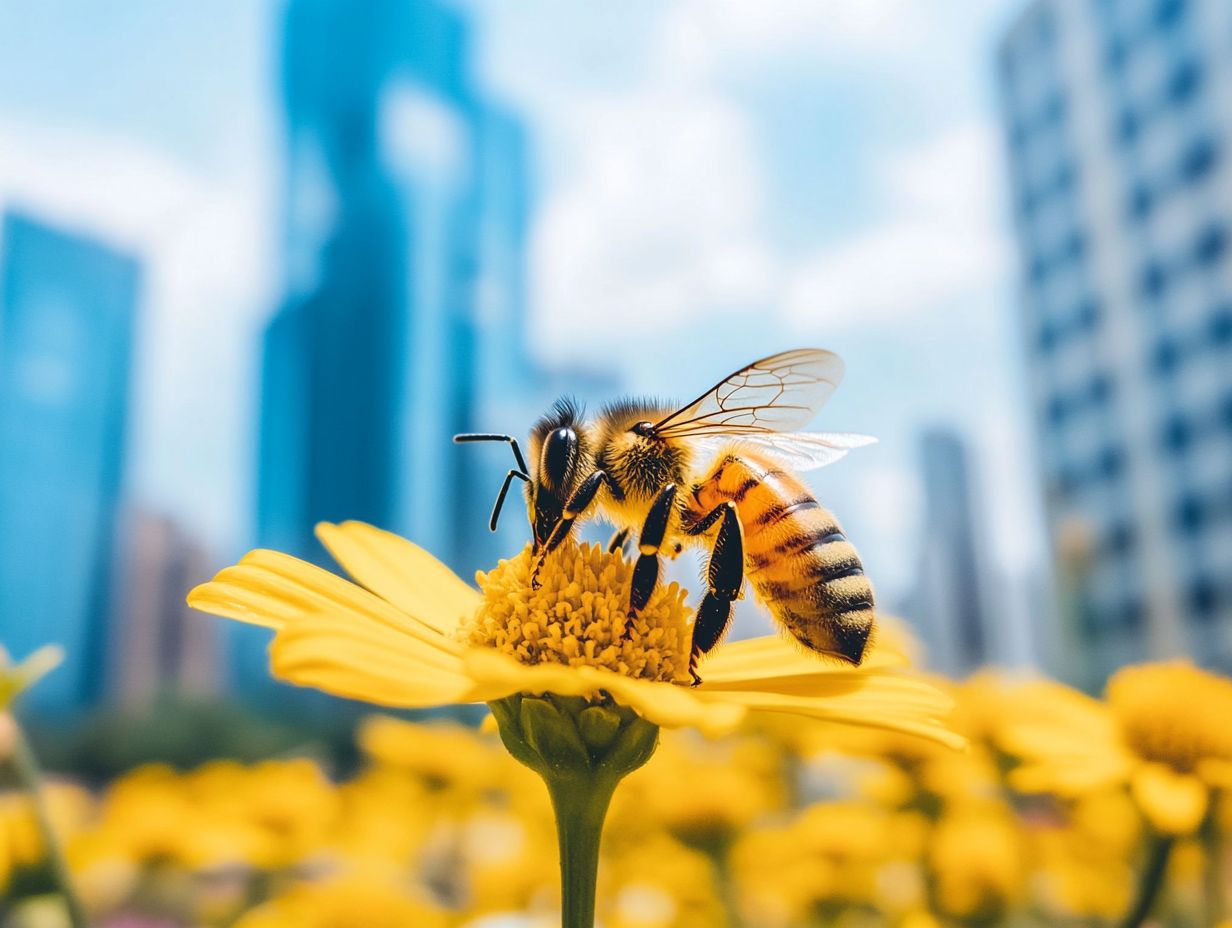
What is pollution and how does it affect bee behavior?
Pollution refers to the presence of harmful substances in the environment. These substances can negatively impact the health and behavior of bees, causing respiratory problems, disrupting their navigation abilities, and affecting their ability to collect food and reproduce. Environmental pollution is a significant factor contributing to these issues.
What are some examples of pollution that can affect bees?
Pollution affects bees in several ways. Common examples include air pollution, water pollution, and pesticide use.
Air pollution from vehicle emissions and industrial activities can expose bees to toxins. It also reduces the quality of the air they breathe.
Water pollution from chemicals and other pollutants can contaminate bee habitats. This disrupts their ability to find clean water sources.
Pesticide use, especially neonicotinoids, can be highly toxic to bees. It affects their behavior and health. Improving air quality is vital for saving our bees!
How does pollution impact bee reproduction?
Pollution harms bee reproduction in many ways! Pesticides can hurt bee eggs and lower the survival rates of young bees.
Air and water pollution can also lead to changes in temperature and humidity levels. These changes affect the growth and development of bee larvae.
These factors can ultimately lead to a decline in bee populations and disrupt the overall balance of the ecosystem.
Nitrogen pollution makes these issues worse by altering the availability of crucial nutrients for plant and bee development.
Yes, pollution can also impact the social behavior of bees. Pesticide exposure, for instance, can affect how bees talk and gather food.
This disruption can ultimately affect the success of the entire colony. Air and water pollution can also contribute to the spread of diseases among bees.
Such diseases lead to changes in social dynamics and behavior within the colony. Raising public awareness about these issues is essential for driving change and protecting bee populations.
Are there any long-term effects of pollution on bee behavior?
Yes, pollution can have lasting effects on bees! Ongoing pollution weakens their immune systems, making them easy targets for diseases and parasites.
This can lead to a decline in the overall bee population and have serious consequences for the pollination of plants and crops.
Ensuring bee diversity is crucial for maintaining resilient ecosystems and agricultural systems.
How can we reduce the negative effects of pollution on bee behavior?
There are several ways we can reduce the negative effects of pollution on bee behavior. These include limiting the use of pesticides and finding alternative methods for pest control.
We can also reduce air and water pollution through sustainable practices and promote the protection and conservation of bee habitats.
Educating others about the importance of bees and the impact of pollution on their behavior can help raise awareness and encourage positive change.
Supporting initiatives by organizations like Natural England can further promote these efforts.

